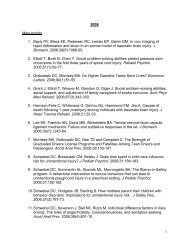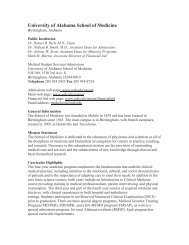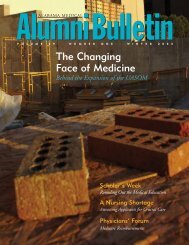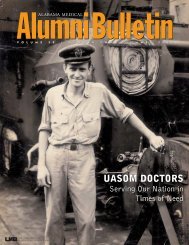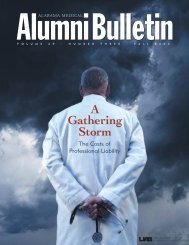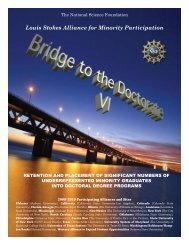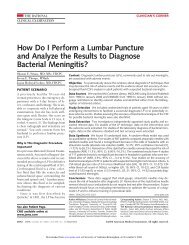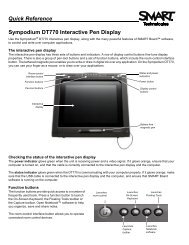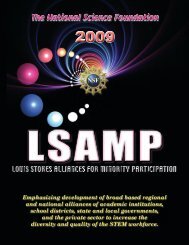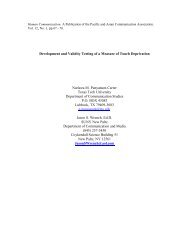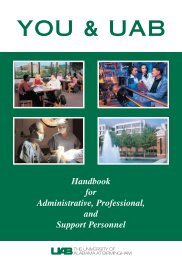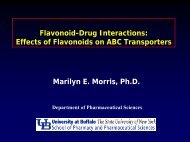the pursuit of parkinson's - The University of Alabama at Birmingham
the pursuit of parkinson's - The University of Alabama at Birmingham
the pursuit of parkinson's - The University of Alabama at Birmingham
You also want an ePaper? Increase the reach of your titles
YUMPU automatically turns print PDFs into web optimized ePapers that Google loves.
B<strong>at</strong>tling Burns and Winning<br />
Tre<strong>at</strong>ment Comes a Long Way<br />
By Roger Shuler<br />
James Cross, M.D., and<br />
Alan Dimick, M.D., along<br />
with many o<strong>the</strong>r physicians<br />
and staff, are part<br />
<strong>of</strong> <strong>the</strong> Burn Center’s<br />
ongoing commitment<br />
to burn care.<br />
When James Cross, M.D., is asked about progress<br />
made in <strong>the</strong> tre<strong>at</strong>ment <strong>of</strong> burns, he thinks<br />
about a scene from <strong>the</strong> 2001 film Pearl Harbor.<br />
“In <strong>the</strong> movie <strong>the</strong>re is a scene where <strong>the</strong><br />
Japanese have <strong>at</strong>tacked, and <strong>the</strong> hospital is inund<strong>at</strong>ed with<br />
p<strong>at</strong>ients,” Cross says. “<strong>The</strong> doctors are triaging <strong>the</strong> p<strong>at</strong>ients,<br />
and when <strong>the</strong>y have a burn p<strong>at</strong>ient, <strong>the</strong>y say, ‘Put him over<br />
<strong>the</strong>re under <strong>the</strong> tree.’ Back <strong>the</strong>n, it was assumed th<strong>at</strong> a p<strong>at</strong>ient<br />
with a severe burn was going to die.”<br />
Th<strong>at</strong> scene was set in 1941. Cross, director <strong>of</strong> <strong>the</strong> UAB<br />
Burn Center, says <strong>the</strong> medical approach to burns has changed<br />
dram<strong>at</strong>ically since <strong>the</strong>n.<br />
“Now we work under <strong>the</strong> premise th<strong>at</strong> most burn p<strong>at</strong>ients<br />
are going to live,” Cross says. “We don’t save everyone. P<strong>at</strong>ients<br />
with severe smoke-inhal<strong>at</strong>ion injuries, and those with burns<br />
over 60 to 70 percent <strong>of</strong> <strong>the</strong> body surface area—we have trouble<br />
saving <strong>the</strong>m. But if <strong>the</strong> burn area is less than th<strong>at</strong>, we work<br />
on <strong>the</strong> premise th<strong>at</strong> we can save <strong>the</strong> p<strong>at</strong>ient.”<br />
Challenges and Complic<strong>at</strong>ions<br />
Burns present some <strong>of</strong> <strong>the</strong> most difficult challenges in medicine.<br />
“With a severe burn, every single organ is affected,”<br />
Cross says. “Dealing with <strong>the</strong> burn to <strong>the</strong> skin is <strong>of</strong>ten <strong>the</strong> easy<br />
part. <strong>The</strong> difficult part comes when <strong>the</strong> lungs go bad, when <strong>the</strong><br />
kidneys and <strong>the</strong> gastrointestinal tract aren’t working.”<br />
For example, a severe burn can cause swelling in <strong>the</strong> GI tract<br />
th<strong>at</strong> makes it difficult for a p<strong>at</strong>ient to absorb nutrients. In fact,<br />
swelling in general is a major complic<strong>at</strong>ion with burns. “When<br />
you get a bee sting, you have swelling right around <strong>the</strong> site,”<br />
Cross says. “A burn is like a total-body bee sting.”<br />
12<br />
For p<strong>at</strong>ients burned over more than 70 percent <strong>of</strong> <strong>the</strong>ir bodies,<br />
<strong>the</strong> mortality r<strong>at</strong>e is very high. “Several things happen,”<br />
Cross says. “Often <strong>the</strong>y don’t make it through <strong>the</strong> initial resuscit<strong>at</strong>ion<br />
effort; <strong>the</strong> insult to <strong>the</strong> body is so gre<strong>at</strong> th<strong>at</strong> <strong>the</strong>y just<br />
can’t toler<strong>at</strong>e it. If <strong>the</strong>y get through th<strong>at</strong>, <strong>the</strong>y <strong>of</strong>ten succumb to<br />
o<strong>the</strong>r complic<strong>at</strong>ions, such as infections or respir<strong>at</strong>ory problems.”<br />
But because <strong>of</strong> progress in burn care, even severely burned<br />
p<strong>at</strong>ients can sometimes pull through. Alan Dimick, M.D., has<br />
seen <strong>the</strong> progress from <strong>the</strong> front lines.<br />
Dimick helped found <strong>the</strong> UAB Burn Center in 1970. He<br />
retired as burn center director in 1998, but he still serves as a<br />
consultant <strong>at</strong> Children’s Hospital and is a site reviewer for <strong>the</strong><br />
American Burn Associ<strong>at</strong>ion’s verific<strong>at</strong>ion program.<br />
“Before I retired, I had 15 p<strong>at</strong>ients walk out <strong>of</strong> <strong>the</strong> hospital<br />
after coming to us with 80- to 85-percent burns,” Dimick says.<br />
“If <strong>the</strong>y were to walk into a room with <strong>the</strong>ir clo<strong>the</strong>s on now,<br />
you couldn’t tell <strong>the</strong>y had a burn.”<br />
Shortly after Dimick joined <strong>the</strong> UAB faculty in 1963, Chief<br />
<strong>of</strong> Surgery Champ Lyons, M.D., asked him to <strong>at</strong>tend a meeting<br />
on burns in Galveston, Texas. “I saw how bad things were in<br />
burn care and how badly we needed to improve it,” Dimick says.<br />
A major step in th<strong>at</strong> direction came when UAB hosted <strong>the</strong><br />
first meeting <strong>of</strong> <strong>the</strong> American Burn Associ<strong>at</strong>ion (ABA) in 1967.<br />
“We had about 200 people <strong>at</strong> th<strong>at</strong> first meeting,” Dimick says.<br />
“Now we have about 3,000 <strong>at</strong> <strong>the</strong> annual meeting.”<br />
Secrets <strong>of</strong> Survival<br />
UAB is one <strong>of</strong> 130 burn centers in <strong>the</strong> United St<strong>at</strong>es and<br />
admits about 250 burn p<strong>at</strong>ients a year. Ano<strong>the</strong>r 150 burn<br />
p<strong>at</strong>ients are admitted each year <strong>at</strong> Children’s Hospital.<br />
A p<strong>at</strong>ient’s length <strong>of</strong> stay, which once was usually two to three<br />
months, now averages 21 to 28 days. But <strong>the</strong> hospital stay is just<br />
<strong>the</strong> beginning <strong>of</strong> <strong>the</strong> challenge. “We call burns a two-year disease,”<br />
Dimick says. “Th<strong>at</strong>’s how long it <strong>of</strong>ten takes to recover.”<br />
When Dimick began to oversee burn care <strong>at</strong> UAB, he did<br />
not have many competitors for <strong>the</strong> job. “Everyone was happy<br />
for me to take care <strong>of</strong> <strong>the</strong> burn p<strong>at</strong>ients,” he says. “You have<br />
p<strong>at</strong>ients with raw, open wounds, crying and smelling bad,<br />
hurting all <strong>the</strong> time. Nobody wanted to deal with <strong>the</strong>m.”<br />
It didn’t help th<strong>at</strong> outcomes <strong>of</strong>ten were not favorable. But<br />
gradually, th<strong>at</strong> began to change.<br />
Early surgery for burn p<strong>at</strong>ients was a major step forward.<br />
“In <strong>the</strong> ’60s and ’70s, we used to wait until <strong>the</strong> burned tissue<br />
was completely <strong>of</strong>f <strong>the</strong> p<strong>at</strong>ient before we did any skin grafting,”<br />
Dimick says. “Now we take <strong>the</strong>m into <strong>the</strong> OR during <strong>the</strong><br />
first couple <strong>of</strong> days. We now know th<strong>at</strong> once you cut <strong>of</strong>f <strong>the</strong><br />
dead tissue and cover <strong>the</strong> burn with a skin graft or artificial<br />
skin, <strong>the</strong> p<strong>at</strong>ient gets much better.”<br />
<strong>The</strong> value <strong>of</strong> nutrition also became apparent. “When you<br />
sustain a burn, <strong>the</strong> body begins working overtime to heal <strong>the</strong><br />
wounds,” Dimick says. “Your metabolic r<strong>at</strong>e goes up 100 to<br />
200 times. So we have to put a tube into <strong>the</strong> stomach and literally<br />
pump food into <strong>the</strong> p<strong>at</strong>ient.”



